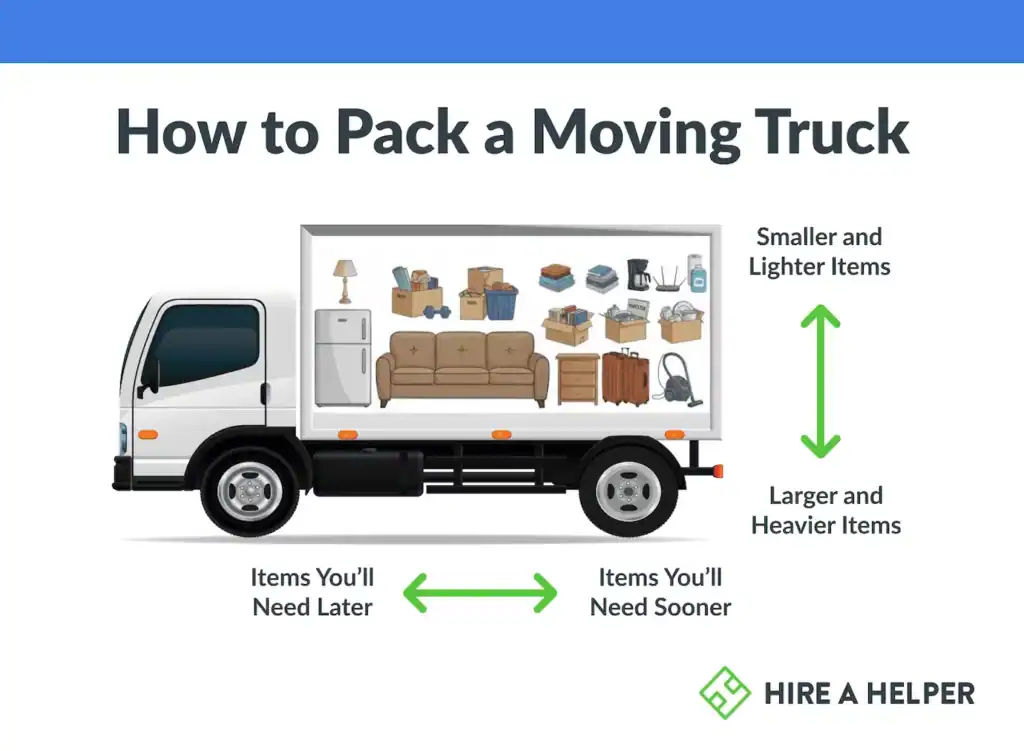Every year, millions of people rent moving trucks to handle their moves. U-Haul alone reports more than 2.5 million one-way rentals annually. With so many families depending on these vehicles, the way a truck gets packed can have a big impact. After all, a careful load keeps furniture safe, saves space, and makes driving easier.
When you have the right supplies, know the order to load things, balance weight correctly, and secure items as you go, you’ll end up with a truck that feels stable and organized instead of crowded or chaotic.
This guide breaks down each step so you can load a truck with confidence. We’ll cover the supplies to gather, how to stack and strap items, and the safety habits for you to load your moving truck with confidence.
Table of Contents
Step-by-Step Guide for Packing a Moving Truck
Packing a truck isn’t difficult, but tossing things in as they come out of the house isn’t the best plan either. The steps below show you how to load in a way that protects your stuff, balances the truck, and makes unpacking less of a hassle.
Gather Supplies Before You Start
Before you lift a single box, make sure you have the right gear. A rental truck gives you space, but it won’t protect your belongings on its own. You’ll want:
- Moving blankets and pads: Rent these from your truck provider or buy them at a home improvement store. They keep furniture from getting scratched and prevent items from rubbing against each other.
- Straps and rope: Look for heavy-duty ratchet straps or thick rope to tie down each section of your load. Bungee cords aren’t strong enough for a full truck.
- Dollies and hand trucks: These make it easier to move large appliances, heavy boxes, or stacks of bins without straining your back. Most rental counters have them available.
- Boxes and bins: Use sturdy, uniform-sized boxes whenever possible. They stack more easily and create a stable wall inside the truck.
Having these supplies on hand before loading day saves time and helps keep the packing process safe and organized.
Plan Your Loading Order
Think top to bottom and front to back. Build the load so it is stable, easy to drive, and easy to unpack.
- Bottom to top: Keep the heaviest items low and toward the front of the box, then lighter boxes and soft items on top.
- Last in, first out: Load the things you will need right away at the very end, closest to the door. Keep essentials like an overnight bag, chargers, meds, and valuables with you, not buried on the truck.
- Tight stacks: Stack boxes by size so walls are even, and fill small gaps with soft items to reduce shifting.
Keep the load balanced left to right. If a refrigerator goes on the left, place another heavy piece on the right so the truck handles predictably.

This order creates a balanced load that’s easier to drive and makes unloading easier. If you haven’t booked a truck yet, it helps to compare sizes and features to find the right fit for your home and budget.
1. Use the Over-Cab Compartment (the “attic”)
That small space above the cab is made for lighter boxes and soft items. Fill it with things you won’t need until you’re unpacking at the new place — extra blankets, towels, or bins of clothes. Pack it tight so nothing shifts, but avoid putting anything heavy up there.
2. Load Large Appliances and Furniture
Start with the biggest, bulkiest items. Refrigerators, washers, sofas, and dressers should go against the truck’s walls. Place them upright and secure them with moving blankets and straps.
Try to distribute weight evenly side to side. For example, if you load a refrigerator on the left, balance it with a couch or dresser on the right. Keeping these items upright also helps protect their internal parts — especially for appliances. Heavy, awkward pieces like sofas, armoires, or pianos should be handled with care, so check out our heavy furniture moving guide for step-by-step tips.
3. Add Boxes by Size and Weight
Next, bring in the boxes. Heavier boxes should be placed first, stacked tightly on the floor. Work your way up with lighter boxes, filling as much vertical space as you can. When boxes are stacked to the ceiling, they create a solid wall that resists shifting.
“It’s tempting to use a car trailer as extra storage space, but…that extra weight can make the truck harder to control, increase the risk of sway at highway speeds, and push braking distances much longer than expected.”
Also, avoid leaving gaps between stacks. Empty spaces let items slide during the drive, which can lead to damage. If you do have small spaces, save them for softer or oddly shaped pieces — they can act as extra cushioning.
4. Fill Gaps With Odd-Shaped Items
Once the big pieces and boxes are set, you’ll notice some open spots. This is where lamps, small chairs, rolled-up rugs, cushions, and similar items come in. Tuck them carefully into gaps to keep stacks tight.
Soft items like pillows or blankets make excellent padding between fragile pieces as well. They act as natural shock absorbers during the drive and help you use every inch of space.
5. Secure the Load
Every section of your load should be tied down before you move to the next. Use ratchet straps or rope to anchor items to the truck’s built-in rails. You should first secure furniture to the walls, then strap stacks of boxes together.
Tight tie-downs prevent boxes from falling and furniture from sliding. Not only does this protect your belongings, but it also makes driving safer. A shifting load can throw off balance and create hazards when braking or turning.
6. Load Essentials Last
Finish by adding the items you’ll need right away. An overnight bag, cleaning supplies, a basic tool kit, chargers, and valuables should be placed near the back of the truck. That way, you won’t have to dig through stacks of boxes at your new place just to find the basics.
Pro Tips to Maximize Space
- Disassemble large furniture like bed frames and tables before loading.
- Wrap fragile items in blankets or bubble wrap, then nestle them between sturdier pieces.
- Place mattresses upright along the sides to act as cushions.
- Fill drawers and suitcases with clothing or linens to save box space.
- Keep similar box sizes together for more stable stacks.
- Don’t overload one side of the truck — balance the weight evenly.
- Slide flat items, like mirrors or TVs in proper boxes, along walls or between mattresses.
- Use every vertical inch of the truck by stacking to the ceiling when it’s safe to do so.
Safety First
When loading a moving truck, you’ll need to keep yourself, your helpers, and your belongings safe. A few smart habits go a long way toward avoiding injuries and damage.
Practice Safe Lifting Techniques

Most moving-day injuries come from lifting wrong, not from the drive itself. Bend at your knees, not at your waist, and keep the load close to your body as you stand. If something feels too heavy or awkward, use a dolly or ask a second person to grab the other end. And don’t twist while you’re holding weight — turn with your feet instead. Taking an extra few seconds to lift safely is better than spending weeks nursing a pulled back.
Avoid a Truck Ramp Accident
Ramps make loading easier, but they’re also one of the most common spots for accidents. A few simple precautions keep you steady:
- Clear the path. Sweep off loose packing materials and check the ground around the ramp before you start.
- Watch your footing. Walk slowly, wear shoes with good traction, and never run up or down.
- Use a spotter. Have someone guide you when you’re rolling a dolly or carrying bulky furniture.
- Secure the ramp. Make sure it’s locked firmly in place before stepping on.
- Take it slow. Backing down with a heavy load? Go step by step and keep your balance.
- Stay centered. Walk in the middle of the ramp, not along the edges where slips are more likely.
- Mind your hands. Be careful when sliding the ramp back into place so your fingers don’t get caught. Double-check it’s stowed and locked before you drive off.
Towing a Car Behind Your Rental Truck? Don’t Pack it Full.
It’s tempting to use a car trailer as extra storage space, but it’s not designed for that. Adding boxes or furniture to a vehicle being towed throws off the balance of the trailer. That extra weight can make the truck harder to control, increase the risk of sway at highway speeds, and push braking distances much longer than expected.
“Load the things you will need right away at the very end, closest to the door. Keep essentials like an overnight bag, chargers, meds, and valuables with you, not buried on the truck.”
Your car can also take the hit — overloaded suspension, broken windows, and interior damage are all common outcomes. Keep the car empty except for what it’s built to carry, and let the trailer do its job safely.
Common Mistakes to Avoid When Packing a Moving Truck
Even with the best intentions, a few simple missteps can cost you time, space, or damaged items. Keep these common mistakes in mind while you load:
- Not measuring ahead of time. Make sure big furniture will fit through the door of the truck and in the space you’ve rented. Otherwise, you could be stuck with a piece you can’t move.
- Forgetting to secure items. Unstrapped stacks or loose furniture can shift and break things once you hit the road.
- Leaving empty gaps. Open spaces let boxes slide and knock into other items, causing damage. Fill any gaps with cushions, linens, or smaller items to keep everything tight.
- Packing essentials too far back. Overnight bags, cleaning supplies, or tools should be near the back door, not buried in the middle.
- Overloading one side. Uneven weight makes the truck harder to drive safely and worsens your fuel mileage. Spread heavy items out to balance the load.
- Skipping furniture pads. A simple blanket can prevent scratches and dents — don’t skip it to save a few minutes.
- Rushing the process. Taking time to stack boxes by size and weight pays off in space saved and fewer broken items.
Frequently Asked Questions
What is the best order to load a moving truck?
Start with the over-cab space (the “attic”) for light items you don’t need right away. Then place large furniture and appliances on the floor against the walls, followed by heavy boxes, then lighter ones on top. Fill gaps with cushions or odd-shaped items, and finish with essentials near the back door.
What is the most efficient way to pack a moving truck?
Use sturdy boxes of similar sizes so they stack tightly. Keep weight balanced from side to side, strap sections down as you go, and take advantage of vertical space by stacking to the ceiling when possible.
How to pack a 20 ft U-Haul truck?
Follow the same steps as any rental truck: attic first, heavy furniture and appliances next, then boxes and smaller items. A 20 ft truck typically fits a 2–3 bedroom home, so planning the order is key to making everything fit securely. If you’re wondering about costs, our breakdown of how much a U-Haul really costs covers mileage, fees, and extras so you know what to expect.
Is it better to pack clothes in bags or boxes when moving?
Both work, but boxes stack more neatly in a truck. Bags can be useful for filling small gaps or padding fragile items. A mix of the two usually works best.

